Abstract
Learning techniques have been developing tremendously and continuously in this modern technological era. Worldwide educators from diverse backgrounds and cultures are well equipped and trained with the recent online teaching methods and tools which are widely accessible, guiding and nurturing the students in a productive and interactive classroom learning environment. There are a lot of e-learning tools, either online or offline. Nowadays, significant studies have indicated Minecraft as one of the best applications for facilitating learning. Therefore, this research will benefit all seekers of knowledge (SoK) in Arabic and Islamic Studies by using the Minecraft application because learning these two subjects has not been implemented in Minecraft education, in addition, Arabic words and fonts cannot be applied in this application either. The data was collected using quantitative methods through the Internet, followed by content analysis to recognise trends regarding e-learning based on the Minecraft research. Accordingly, Minecraft will facilitate a more effective and enjoyable 21st century approach and experience in the teaching and learning of classical texts.
Keywords: Arabic, Islamic studiess, Minecraft, sok
Introduction
In this new millennial age, amidst the technology avalanche, e-learning and e-education are two of the best communication processes to help students understand in a better and more effective way.
Malaysia’s government has spent millions on initiatives to implement e-learning in higher education institutions, offering vast business opportunities to technology providers (Malaysian Investment Development Authority, 2021). Prior to COVID-19, e-learning was commonly known as a technology trend that provided an opportunity for lifelong learning and enhanced digital literacy skills. The Malaysia Education Blueprint 2015–2025 (Higher Education) emphasised the significance of digital literacy, critical thinking, and problem-solving as 21st- century learning skills that can potentially aid students to thrive in IR 4.0 (Malaysian Investment Development Authority, 2021), illustrating the importance of e-learning in the education landscape.
In 2020, the Malaysian government move forward to lead Malaysia towards the digitization world in 2030 in all aspects as known as 10-10 Malaysian Science, Technology, Innovation and Economy (Malaysia, 2020) Framework. These tremendous frameworks discover 10 fields to advance and develop the country's economy booster, societal wellbeing, and dual impact enabler (Malaysia, 2020), for example, in terms of: 1) Energy 2) Business and Financial Services 3) Culture, Art, and Tourism 4) Medical and Healthcare 5) Smart Technology and System 6) Smart Cities and Transportation 7) Water and Food 8) Agriculture and Forestry 9) Education and 10) Environment and Biodiversity.
This research would like to respond to the government's call to get involved in leading Malaysia forward together, as mentioned by Khairy Jamaluddin: “I hope that this will be a new dawn for Malaysia, in forging a trajectory to become a dynamic global” (Malaysia, 2020). Therefore, this research will contribute to an education system that designs global online learning and then promotes our module at the international level.
For that reason, research has identified digital games as the best learning tool for teaching Islamic knowledge to Muslim children. According to a recent study, Islamic digital ames have managed to attract the attention of users and enthuse them to want to learn more (Aziz et al., 2019)
At the present time there are many available online Arabic learning tools and educational games that have been studied by scholars and researchers, namely Bi-Tokoh (Rosdi, Rahim, et al., 2022). Al-Jumal’s Cube (Rosdi, Ahmad Rosdi, et al., 2022). Several accessible Arabic online tools and educational games are available on Arabicfortourism by using the Joomla platform (Ghani et al., 2016). Development and Evaluation of i-Mutawwif: A Mobile Language Traveller Guide in Arabic for Mutawwif, Umrah Tour Guide (Sahrir et al., 2018), Implementation of the Addie Model in Hisbah Reflection through Mobile Phone Application (Makhsin et al., 2018), and Development of Addie Model For Chapter Taharah Learning Based On Game Application In Junior High School, (Mardianto et al., 2022).
For a more advanced explanation from this research, the researcher will design an instructional module for learning the Arabic language and Islamic studies through the Minecraft application. Minecraft is chosen for its dynamic elements. To reiterate clearly: Minecraft contains three significant elements that make it an effective learning tool. Firstly, Minecraft’s features are designed for teaching: Education Edition has features built specifically for learning environments to support collaboration, assessment, coding, and more. Furthermore, Minecraft Pre-built Lessons allow its users to browse over 600 standards-aligned lessons to engage across the curriculum. Users can even write and submit their own Minecraft lessons. Additionally, Minecraft Cross-Curricular Support gives users the opportunity to learn with Minecraft across the curriculum, as they are offering coursework spanning STEM, Coding, SEL, History, Language Arts, 21st Century Skills, and more (Microsoft, 2023a). Last but certainly not least, Minecraft is accessible and available for Windows and Mac users, providing students with the platform to demonstrate teamwork while allowing teachers the option to incorporate online elements into teaching and learning practises (Microsoft, 2023b).
Interestingly, various learning subjects have already utilised Minecraft as a learning platform and e-learning module. To put this in a clear manner, many researchers have adopted the Minecraft application to develop learning modules for subjects or courses, and this includes The Effects of Digital Game-Based Learning Using Minecraft Towards Pupil’s Achievement in Fraction (Tangkui & Tan, 2020), Enhancement of Achievement in Fractions: A Conceptual Framework for Digital Game- Based Learning using Minecraft (Tangkui & Tan, 2020), English Language (Yeh et al., 2017), Mathematics (Ku et al., 2014), Science (Hwang et al., 2014), and Motivational (Iacovides et al., 2011). Evidently, these studies have proven the effectiveness of Minecraft as an e-learning module for learning and teaching purposes.
There are a lot of research studies about Minecraft’s educational applications, for instance in English language, mathematics, Mandarin, science, biography, history, and Islamic studies. Regrettably, no such Arabic language can be used by using the Minecraft application because, during the researcher’s experience and his experiment, the Minecraft educational application does not support Arabic words yet but can still be used in other ways.
Regarding this problem, this research would like to take this opportunity to design and develop a module in Arabic language and Islam Studies by using the Minecraft application and make Arabic writing and text usable and functional in Minecraft in order for students and teachers can use this application in Arabic language and Islamic studies learning.
The closest attempt to integrate Minecraft educational applications in Arabic e-learning and e- education were found in the research in the teaching of English, Mandarin, mathematics, and science, which proved that Minecraft is the best learning method nowadays. As a result, this research would like to design an instructional module in the Minecraft educational application through the Arabic language and Islamic studies.
The purpose of this research is divided into two views related to each other, which are collecting data and analysis and being practical. So, in terms of the collecting data, it is to get know a model of the design and development of the Minecraft Application educational and apply it into Arabic language and Islamic studies for teaching and education learning in class.
Research Methods
This research will utilise quantitative based on library. This research chooses the recent studies because to prove that the Minecraft applications are suitable as an e-learning nowadays in all knowledge especially in Arabic language and Islamic studies. The literature review focuses on the effect of Minecraft, its background, and the positiveness of technology in e-learning.
Finding
As a result, it can be concluded from this research that a lot of studies have been done and it has been proven that Minecraft is an effective and interesting e-learning method. There are five studies which are, 1) The Effects of Digital Game-Based Learning Using Minecraft Towards Pupil’s Achievement in Fraction (Tangkui & Tan, 2020), 2) Enhancement of Achievement in Fractions: A Conceptual Framework for Digital Game
Based Learning using Minecraft (Tangkui & Tan, 2020), 3) English Language (Yeh et al., 2017), 4) Mathematics (Ku et al., 2014), 5) Science (Hwang et al., 2014), and 6) Motivational (Iacovides et al., 2011). Figure 1 depicts the most recent Minecraft research. Recent Minecraft research includes six subjects: English, Fraction, Mathematics, Science, Motivation, and Digital Game-Based Learning.

Enhancement of Achievement in Fractions: A Conceptual Framework for Digital Game- Based Learning using Minecraft
Last two years, there were the article discussed a conceptual framework for digital game-based learning using Minecraft for enhancement of achievement in fraction, the article wrote by Rayner bin Tangkui and Tan Choon Keong in July 2020. Therefore, the main objective their article is to discover the conceptual framework for the development of a virtual learning environment through digital game-based learning that applies Minecraft to increase pupils’ achievement in fractions (Tangkui & Tan, 2020), especially to increase the assessment Trends in Mathematics and Science Studies (TIMSS) and Program for International Student Assessment (PISA).
Hence, Minecraft provides the 3D blocks that can help students learn fractions easily and interestingly. The blocks can be arranged in a way that can produce a representative structure or object fraction (Tangkui & Tan, 2020).
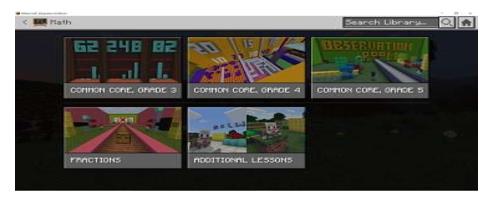
As you can see the Figure 2 above give a two lessons and modules in fractions by John Milner and Trish Cloud & Jennifer. So, the student can choose any lesson and do it by himself.
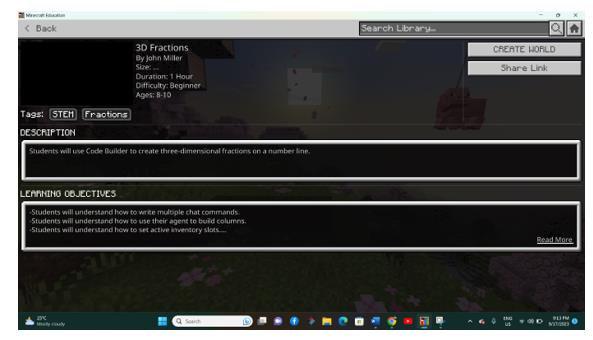
The Figure 3 above shows two elements: the first is the description, and the second is the learning outcome. Thus, it can help student indecently to learn fraction easily and effective.
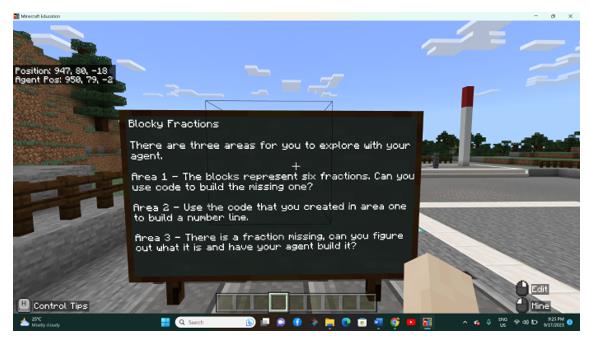
The Figure 4 is explained about the information and instructions. These instructions were created by the teacher to help the student know how to answer the fraction comfortably and straightforwardly. To conclude that this article was the first step regarding their studies. This article continues with Discussion 2 and the findings of their research.
The Effects of Digital Game-Based Learning Using Minecraft Towards Pupil’s Achievement in Fraction
In 9 September 2020, the objective of this article is to investigate the effect of digital game-based learning using Minecraft towards pupils’ achievement in fractions. At the end, game-based learning using Minecraft in the teaching of mathematics increases the pupil’s achievement more than the conventional approach.
It is because Minecraft provides a chance to pupil’s by using box in fraction in an effective way. Thus, it is also very interesting as an e-learning approach because it encourages them to participate in this application.
Therefore, this article would like to encourage to all educators, instructors and teachers to use game- based learning using Minecraft to help pupil’s get the highest score in a two majors international assessment which are Trends in Mathematics and Science Studies (TIMSS) and Program for International Student Assessment (PISA) in future. Figure 5 below shows an example of the module in the Mathematic section through Minecraft.
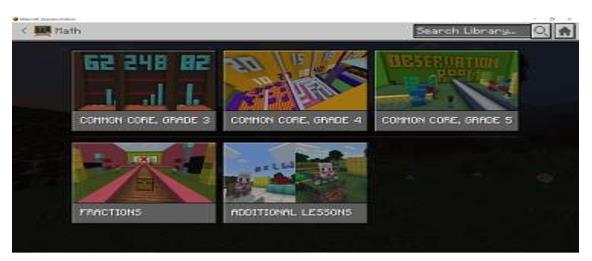
Open-Ended Tasks Promote Creativity in Minecraft
The latest article about Minecraft is written by Yue Fan, H. Chad Lane and Ömer Delialioğlu which is Open-Ended task promote creativity in Minecraft in April 2022. They elaborate on how Minecraft creativity can improve student learning and teaching. Then, they used two conventional approaches to measure creativity: the Alternative Uses Test (AUT) and the Consensual Assessment Technique (CAT).
This study explains the important of Minecraft as educational technology in term of authentic learning environment and creativity. The outcome of an authentic learning environment is that they can use blocks to create, innovate, and design the image or picture. It can also be played individually or in groups. The outcome of creativity by using Minecraft can help people, especially students, in terms of divergent thinking because Minecraft gives them the chance to build, explore, and collaborate while playing and learning. At the same time, it can also help students develop a problem-solving mindset. Therefore, Minecraft shows that it is useful and effective for learning.
As a result, participants who engaged in the open-ended task received significantly higher CAT scores than those in the well-defined task group, and (2) among variables such as the level of skill or experience, interest in Minecraft, and materials (blocks) used in Minecraft, only the level of game interest had a significant influence on the CAT score (Fan et al., 2022).
Conclusion
In this era of globalisation, the researcher wishes to design and develop a similar learning framework and introduce a module for learning the Arabic language and Islamic studies through the Minecraft application, because Minecraft nowadays is one of the best methods in educational games.
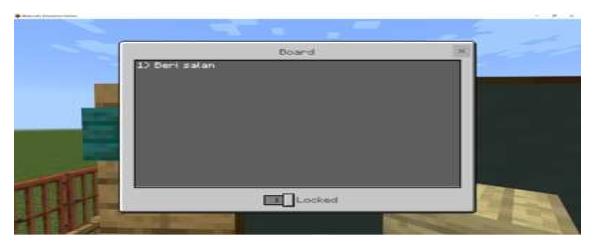
The Figure 6 illustrates how the lecturer or instructor can utilise Minecraft to construct questions and quizzes.
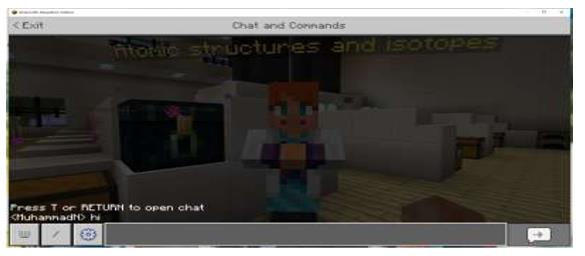
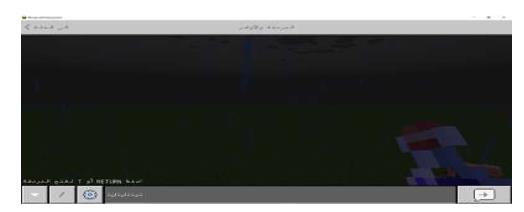
The Figure 7 and Figure 8 above exhibit how the lecturers can write anything related to learning the Arabic language and Islamic studies, and they can communicate with each other, but this educational learning does not support Arabic fonts yet but can still be used in other ways.
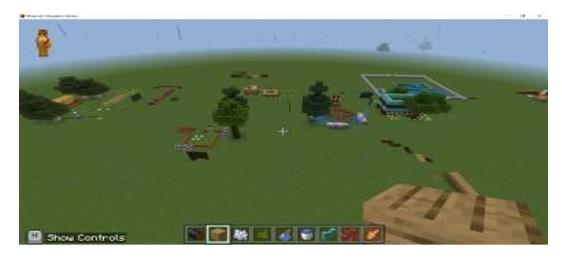
Figure 9 above demonstrate how students can join and learn together using Minecraft. Minecraft Cross-curricular Support provides users with the opportunity to learn across the disciplines spanning from STEM, Coding, SEL, History, Language Arts, 21st Century Skills, and more, (Microsoft, 2023a).
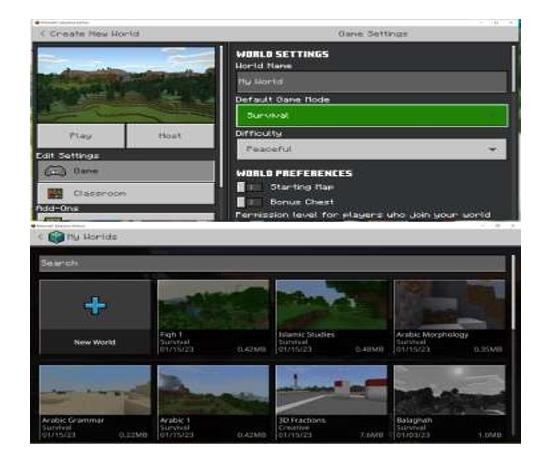
The Figure 10 picture shows that a lecturer or instructor can create any topic and chapter for their students; for example, in this research, we can add Fiqh 1, Islamic studies, Arabic morphology, Arabic grammar, Arabic 1, Balaghah (Arabic rhetoric), and etc.
In conclusion, this research would like to develop a similar learning framework and introduce Minecraft focusing on Arabic language and Islamic studies, as a guide to facilitate the Arabic language and Islamic studies at the International Islamic University Malaysia (IIUM) and to all seekers of knowledge (SoK) Arabic language and Islamic studies.
Acknowledgement
This research paper is an output of International Sponsored Research IIUM SP122-151-0151. We would like to thank our team members, especially Muhammad Nur Farhan Bin Zamziba, Prof. Dr. Rahmah Binti Ahmad H. Osman, Dr. Muhammad Anwar Bin Ahmad, Rabiatul Fatimah Azzahra Binti Rashid, Dr. Mohamad Lukman Al Hakim bin Md. Noor, Rizka Rivensky and Umar Arrasyid Bin Ahmad Zabidi, because they contributed, supported, and indicated that they would like to write this research.
Last but certainly not least, we would like to give a great many thanks to the International Conference of Research on Language Education 2023 (I-RoLE 2023) for giving us the chance to take part in this conference to express our idea that suits the theme of the conference, which is “Embracing Change: Emancipating the Landscape of Research in Linguistics, Language, and Literature.” It was a great pleasure and a fantastic experience because we got to know other researchers and formed bonds with them. May Allah bless all of us and guide us to achieve our dreams.
References
Aziz, M. S. A., Auyphorn, P., & Syarqawy, M. (2019). Exploring the Use of Digital Games as a Persuasive Tool in Teaching Islamic Knowledge for Muslim Children. International Journal of Advanced Computer Science and Applications, 10(6). DOI:
Fan, Y., Lane, H. C., & Delialioğlu, Ö. (2022). Open-Ended Tasks Promote Creativity in Minecraft. Educational Technology & Society, 25(2), 105–116.
Ghani, M. T. A., Daud, W. A. A. W., & Sahrir, M. S. (2016). Arabic For Tourism Purpose Via Web-Based Learning n Poly-Tech MARA College, (KPTM). Carnival on E-learning (IUCEL) 2016, 1.
Hwang, G.-J., Hung, C.-M., & Chen, N.-S. (2014). Improving learning achievements, motivations and problem-solving skills through a peer assessment-based game development approach. Educational Technology Research and Development, 62(2), 129-145. DOI:
Iacovides, I., Aczel, J., Scanlon, E., Taylor, J., & Woods, W. (2011). Motivation, Engagement and Learning through Digital Games. International Journal of Virtual and Personal Learning Environments, 2(2), 1-16. DOI: 10.4018/jvple.2011040101
Ku, O., Chen, S.-Y., Wu, D.-H., Lao, A.-C.-C., & Chan, T.-W. (2014). The effects of game-based learning on mathematical confidence and performance: High ability vs. low ability. Educational Technology & Society, 17(3), 65-78.
Makhsin, M., Hj Azid@Aziz, N., Nurmaya Jumiran, S., Fadhli Ilias, M., & Amirul Fahmi Mat Sukeri, M. (2018). Implementation of Addie Model in Hisbah Reflection through Mobile Phone Application. International Journal of Engineering & Technology, 7(3.7), 290. DOI:
Malaysia, A. S. (2020). 10-10 Malaysian Science, Technology, Innovation and Economy (MySTIE) Framework: Trailblazing the way for prosperity, societal well-being & global competitiveness. Kuala Lumpur: Akademi Sains Malaysia.
Malaysian Investment Development Authority. (2021). Evolution of e-Learning in the Malaysian Higher Education Institutions. https://www.mida.gov.my/mida-news/evolution-of-e-learning-in-the-malaysian-higher-education-institutions
Mardianto, M., Matsum, H., & Sarmita, D. (2022). Development of Addie Model for chapter Thaharah learning based on game applications in junior high school. Nazhruna: Jurnal Pendidikan Islam, 5(2), 543-554.
Microsoft. (2023a). What Is Minecraft Education. https://education.minecraft.net/en-us/discover/what-is-minecraft
Microsoft. (2023b). Minecraft: Java & Bedrock Edition for PC. https://help.minecraft.net/hc/en-us/articles/6657208607501-Minecraft-Java-Bedrock-Edition-for-PC-FAQ
Rosdi, M. M. A., Ahmad Rosdi, M. A., AHO, R., Rashid, R. F. A., & Zamziba, M. N. F. (2022). Bi-Tokoh. Conference on Future and Sustainable Education (CFSE 2022), Centre for Foundation Studies. International Islamic University Malaysia.
Rosdi, M. M. A., Rahim, A. A. H., Tawpik, M. N. H., & Rashid, R. F. A. (2022). Constructing sentence with Al Jumal’s cube. In: Innovation in Teaching & Learning Competition, 30 June 2022, Virtual.
Sahrir, M. S. B., Yahaya, M. F., Ismail, T., Zubir, M. A., & Ahmad, W. R. W. (2018). Development and Evaluation of i-Mutawwif: A Mobile Language Traveller Guide in Arabic for Mutawwif (Umrah Tour Guide). International Journal of Interactive Mobile Technologies (iJIM), 12(2), 54. DOI: 10.3991/ijim.v12i2.7708
Tangkui, R., & Keong, T. C. (2020). Enhancement of achievement in fractions: A conceptual framework for digital game-based learning using Minecraft. https://www.researchgate.net/publication/353193215_Improving_Achievements_in_Fractio ns_A_Conceptual_Framework_for_Digital_Game-Based_Learning_Using_Minecraft
Tangkui, R., & Tan, C. K. (2020). Pembelajaran berasaskan permainan digital menggunakan Minecraft: Peningkatan pencapaian murid dalam pecahan [Digital game-based learning using Minecraft: enhancement of pupils’ achievement in fractions]. e-Jurnal Penyelidikan dan Inovasi, 75-90.
Yeh, Y.-T., Hung, H.-T., & Hsu, Y.-J. (2017). Digital Game-Based Learning for Improving Students' Academic Achievement, Learning Motivation, and Willingness to Communicate in an English Course. 2017 6th IIAI International Congress on Advanced Applied Informatics (IIAI-AAI). DOI:
Copyright information

This work is licensed under a Creative Commons Attribution-NonCommercial-NoDerivatives 4.0 International License.
About this article
Publication Date
25 September 2023
Article Doi
eBook ISBN
978-1-80296-964-1
Publisher
European Publisher
Volume
7
Print ISBN (optional)
-
Edition Number
1st Edition
Pages
1-929
Subjects
Language, education, literature, linguistics
Cite this article as:
Zamziba, M. N. F. B., Osman, R. B. A. H., Ahmad, M. A. B., Rashid, R. F. A. B., Md. Noor, M. L. A. H. B., Rivensky, R., & Zabidi, U. A. B. A. (2023). Applying Minecraft to Learn Arabic Language and Islamic Studies: Literature Review. In M. Rahim, A. A. Ab Aziz, I. Saja @ Mearaj, N. A. Kamarudin, O. L. Chong, N. Zaini, A. Bidin, N. Mohamad Ayob, Z. Mohd Sulaiman, Y. S. Chan, & N. H. M. Saad (Eds.), Embracing Change: Emancipating the Landscape of Research in Linguistic, Language and Literature, vol 7. European Proceedings of Educational Sciences (pp. 532-542). European Publisher. https://doi.org/10.15405/epes.23097.48

